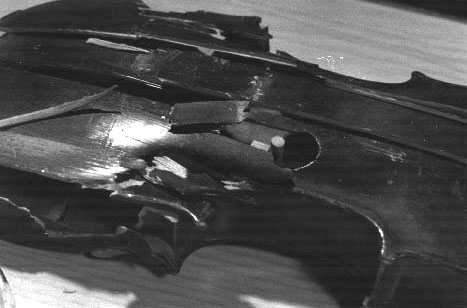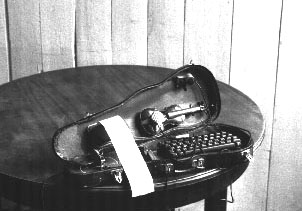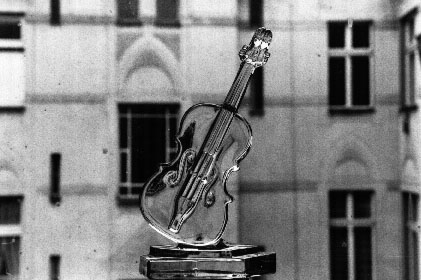

Last year, in the mens' toilet of a well known Berlin railway station, a brown paper package was found by the early morning cleaner. On further investigation it was found to contain a music score - this took some time to ascertain because most of the score consisted of seemingly random numbers and instructions; there was very little in the way of traditional notation. The music turn out to be none than other than the missing Violin Concerto of Johannes Rosenberg - the famous Australian violinist and composer.
The score of this legendary violin concerto went missing in the early 1950s, when Rosenberg was still at the height of his virtuosic abilities. It was never performed. Indeed it is clear that this music was unperformable in a traditional sense. A realisation of the score is only now possible with the help of recent computer technology.
Apart from the impossibly difficult music - the manuscript contains all kinds of unlikely related material which predicated the computer information revolution of the present day; the referential clues' in the score deal mainly with communications systems information. For example - the Berlin U' Bahn layout; a list of French telephone subscribers; civil and military aircraft flight paths; the plans of American communication bases in Australia; print outs of Swiss bank accounts.
This might be the reason why, it is strongly suspected, the CIA were somehow involved in the disappearance of the Violin Concerto . Also at that time, Rosenberg was a member of the Communist Party in Australia (having returned to Sydney after working with Toscanini and the NBC Orchestra). In an interview with The Sydney Herald (dated 19/2/1951) he was convinced of the conspiracy against him and his music -'Let no man have any doubt, we are dealing today with dark forces of Capitalist intrigue determined - at all costs - to destroy Socialism and the development of a new functional violin concerto'. We see here how Rosenberg in fact was predicting the demise of neo-reactionary, Stalinist, Revisionary Eastern Europe. For a reconstruction of this music, it was considered that contact with Rosenberg would be imperative.However, except for a brief interview with a Berlin newspaper, it has been impossible to locate the composer - he has simply vanished (again). So, in this recording we have kept, as far as possible to the instructions written in the score - using authentic mid 20th Century playing techniques, the specified performance locations, etc. Since the solo part is unplayable by any living violinist (other than Rosenberg himself, of course), we have tried to realise it using a computer programme developed at the STIEM electronic music studios in Amsterdam. Although it was hard to persuade them, the Philharmonic performed the orchestral passages (eg Bars 342-675) while travelling on line 9 of the Berlin U" Bahn - as specified in the score. In all other respects, the Concerto broke new ground in terms of instrumentation, geographical venue, and duration. In many ways the Concerto of Rosenberg can be considered the first post-modern' composition and as the cliche says - way ahead of its time'. What other violin concerto written in this century expounds such a wealth of sonic collisions and synchronistic events? From the Shona (conical shawm) of Peking to the modified tuning of the small Harmonium (left to the climatic extremes for 10 years in the Australian outback); from Haus Musicians playing the Nafir (very long trumpets) in Nigeria to a prepared' piano, left in the Amazon Jungle by missionaries before the war: the score includes parts for a dance band, an explosive version of the Beethoven violin concerto, a traditional song performed by a football crowd in Italy, and a Laplander in mid orgasm. And what is the common link in all these sonic components? The answer is Rosenberg's Unified Music Relativity Theory .
|

|
Some background information is necessary at this point. In his youth Rosenberg was attracted to the so-called Epimenides Paradox, which in up-dated language asks the question -is "this statement is false", true or false? He went on to consider a violin language in which the violin could pronounce - "this is not violin" (the idea, like many of Rosenberg's was stolen - in this case by Magritte in his painting Ceci n'est pas une pipe ). From there it was a simple jump to make a violin music which could say "this is not violin music". In 1931, in a paper entitled Undecidable Propositions', Godel's Theorem first appeared -
'To every w-consistent recursive class K of formulae there corresponds recursive class sign R, such that neither v gen r nor Neg (v gen r) belongs to Fig (k) (where v is the free variable of r), or to put it simply - consistent formulated axioms of number theory include undecidable propositions. Now it is one thing to talk about language with language, and another to connect the idea of self-referential statements with number theory - but it took a genius like Rosenberg to see that a statement of paradox about music can be expressed simply in numbers - and thereby predict the future development of computer music as we know it today.
In the Second World War, Rosenberg flew as a fighter ace with the Imperial Japanese Air Force. It was while he was in the middle of a failed suicide dive on the American aircraft carrier Enterprise that his Unified Music Relativity Theory suddenly came to him. What was missing, however, was a language with which to express this mind boggling piece of information. In 1945 Rosenberg was the fastest tapper' of codes in Japan and it became clear to him then that a binary number system was required for the development of his music. Within a few months he had worked out a combined machine, assembly and violin language to work with on a prototype computer at San Diego University (where he had been invited to lecture, after the war, on music theory and atomic physics). At this time he developed the search' programmes which are so vital in the realisation of Violin Concerto .
With regard to Western music models for his Violin Concerto , Rosenberg's preferences for the Second Viennese School receive a high profile in this composition. In particular, one can identify Schoenberg's Variations for Orchestra op.31 as a district influence. The extreme use of very colouristic' orchestration of the tone rows fulfils two functions (in Rosenberg and Schoenberg pieces). Firstly, as a kind of expanded tonality and secondly, as a vehicle to carry the important melodic motive, including the key B A C H motive which acts as a secret motto dominating the Variations .
But unlike the Schoenberg, in which the theme determines the length and character of the nine basic variations, Rosenberg uses a set of algorithms to continually interpolate the basic tonal material - a constant variation form. As you will hear, this gave rise to a set of orchestration parameters that even Rosenberg's inventive mind would have found hard to imagine in 1951. Perhaps the most radical structural device that algorithms generate is the ability for the solist to jump out of the system' altogether - this became known in the late Rosenberg works as the Weekend Factor'. And as with all Rosenberg composition, he gives listings, in an exponential (choice/duration) equivalence tested field of alternative orchestrations. For example, in Bar 3245 (or 182) the pitch G1 can be realised as a pizzicato on the violin; or as the sound of a large industrial pneumatic hammer; or played with full orchestra in unison; or realised with a digital recording of a monkey's fart.
But in the final analysis it is the Unified Music Relativity Theory that underpins the whole structure of the Rosenberg Violin Concerto . As with the whole score, details of the theory must be withheld from publication due to copyright and other legal restrictions. However, the score contains all the algorithms used to formulate the theory. So, it is possible (for some one with the genius of a Rosenberg) to arrive at the same conclusion as he did almost half a century ago.
Rosenberg:Range Searching
Given a set of points in a plane, it is natural to ask which of those points fall within a specified area. Example: List of all cities within 50 miles of a United States military base. This can be realised with a row of tones corresponding to US cities. It can be readily extended to other musicological problems. Example: a list of all those people between the ages of 21 and 25 with incomes between $70,000 and $200,000 who play the violin. The data files on people's names, ages, musical ability, and incomes fall within a certain rectangle in the target plane. Extension to more than two dimension is immediate. If we want a list of all stars within 50 light years of the sun, we have a three dimensional problem, and if we want the musical, rich yuppies of the previous bars to be also tall and female as well, we have a four dimensional problem. In fact, the dimensions of such problems can become rather high.
Begin if c violin.next=zthen sort:=c else begin a:=c; for I:=2 to N div 2 do c: violin.next; b:=c violin.next; c arrow.next:=z if pass=2 then middle:=b violin.p.x; C:merge(sort(a.N div 2).sort (b.N-(N div 2))); sort:=c; if pass=2 then begin a:=c; pl:=z violin,p; p2:=z violin.p; p3:=z violin.p; p4=z violin.p; Repeat if abs(a violin.p.x-middle), min then begin check (a violin.p.p1); check (a violin.p.p2); check (a violin.p.p3); check (a violin.p.p4); p1:=p2; p2:=p3; pe:=p4; p4:=a violin.p End; a:=a violin.next until a=z end end; end;
music
Rosenberg: Network Flow
Bar 675 to 685 can be interfaced with any closed communications systems. Example: West Berlin U' Bahn system. Consider a network of pipes, interconnected with various sized violins, with switches controlling the direction of flow at the junctions. Suppose further that the network has a single source (say in East Berlin) and a single destination (we can't say) to which all the pipes and therefore the violins, ultimately connect. Which switch settings will maximise the amount of flow from source to destination? Complex interactions involving sound material flow at violin contact points make this a non-trivial interface.
Music
When violinists say random , they really mean arbitrary . Random is defined mathematically; arbitrary is saying that any number will do. There is no way to produce true random numbers on any deterministic device or violin. If the numbers or pitches it will produce can be deduced, how can it be random?
Music
Rosenberg: The Perfect Shuffle
The only problem with the Perfect Shuffle is that the wires used for interconnection are long. Furthermore, there are many wire crossings: a shuffle with N wires involves a number of crossings proportional to N 2. These two properties turn out to create difficulties when a Perfect Shuffle machine is hooked up to large string section - such as one might find in the Symphony Orchestra. Long wires lead to time delays and crossings make the chances of a musical catastrophe quite serious.
Music
During each shuffle, the processor reads one input from the left, one from the top, and one from the right; performs a simple computation; and writes one output to the left and one output to the right . Specifically, the right gets whatever was on the left input, and the left output gets whatever was on the left input, and the left output gets the result by multiplying together the left and top inputs and adding the right input. Or to put it another way...
Music and
violin:-0; repeat Violin:=violin=1until (violin=M=1) or (a(0.violin),0); p:=0;repeat p:=p+1 until (p=N+1) or (a(p.violin).0); for i:= p+1 to N do if a(i.violin).0 then if (a(i.M+1)/a(i.violin)),(a(p.M+1)/a(p.violin) then p:=I; if (violin,M+1) and (p,N=1) then pivot (p.violin) until (violin=M+1) or p=N+1); end;
music
Rosenberg Exhaustive Search
Suppose we have an algorithm that makes violin velocity proportional to N2. If we were to have a violin 1000 times faster that the fastest super-violin available today, then we could perhaps solve a problem for N=50 in an hour's time. But in two hour's time we could only do N=51, and even in a year's time we could only get N=59. And even if a new violin were to be developed with a million times the speed, and we were to have a million such violins available, we couldn't get to N=100 in a year's time.
|

|
And the most famous problem in an exhaustive search is the type about the travelling violinist; given a set of N cities, find the shortest route connecting them all, with no city visited twice. Many advanced methods have been developed for the problem, but it is still unthinkable to solve an arbitrary instance of the problem N=1000.
Music
A great many algorithms are based on the principle of recursively decomposing a large violin into smaller ones, using solutions to the subviolins to solve the original problem. The running time of such algorithms is determined by the size and number of the violins and the smell of decomposition. All forms of music can be decomposed in this way.
Rosenberg: Miscellaneous search
Apart from being the first violinist to climb Mt.Everest in 1959, Rosenberg holds two world records on the violin. His detache bow stroke was timed at over 1000 individual different tone/strokes per minute in 1953 - thus beating the original record of 960 strokes, set by Heifitz in 1934. Rosenberg also holds the world record for Violin Trowing - 94.6 metres for a single violin; 72.3 metres for two violins thrown simultaneously ( 1959 D.D.R. National Championships).
It is commonly thought that the Italians invented the violin. However, in one of the musicological coups' of this Century, Rosenberg has proved, beyond doubt, that it was in fact the Chinese. When Marco Polo returned home to Venice in 1295, he brought with him from China - the plans for (what was to become) the state of art Cremonese Violin. They pre-date the earliest painting of a violin by over 200 years (fresco by Garofalo in the Sala del Tesoro, Ferrara 1505). But the Italian connection continues with revelations in last week's press that A.C. Milan Football Club has been involved in a huge world-wide black market trade of millions of Skylark' Chinese violins. "It's a whole new kind of narcomania" says Hype Magazine. "People are through with smoking drugs and shooting up; now everybody's into the violin thing".
An investigative probe by a French journal has revealed that in the late 40s, Rosenberg was secretly flown to France to take part in the first experiments with cloning'. What actually took place in the laboratories at B.O.U.C.A.M. is not certain. However, a statistical scan of telephone subscribers in this area reveal an extraordinary number of recent registrations under the name Rosenberg. It is perhaps not conjecture to consider that there may be in existence - other missing violin concertos of an identical nature!
Between 1957 and 1962, Rosenberg worked as a cryptologist for the East German authorities. Much of his time was spent reading sex magazines, as his employers were convinced that the magazines were full of coded messages for imperialist agents working in the G.D.R. The state police's obsession with it eventually came to a head in 1969 when the scandal was uncovered in a party purge (we would like to thank the American House, Berlin for allowing us to use this confidential information).
Nondeterminism:(The Rosenberg Factor)
In the last bars of the Violin Concerto , Rosenberg clearly decided to think the unthinkable' and introduced a non-deterministic polynomial search program. One might ask, why introduce a violin that makes difficult problems seem trivial? Or to put it another way - as powerful as no-determinism is, no one till now has been able to prove that a musical problem worth solving by this method actually exists.